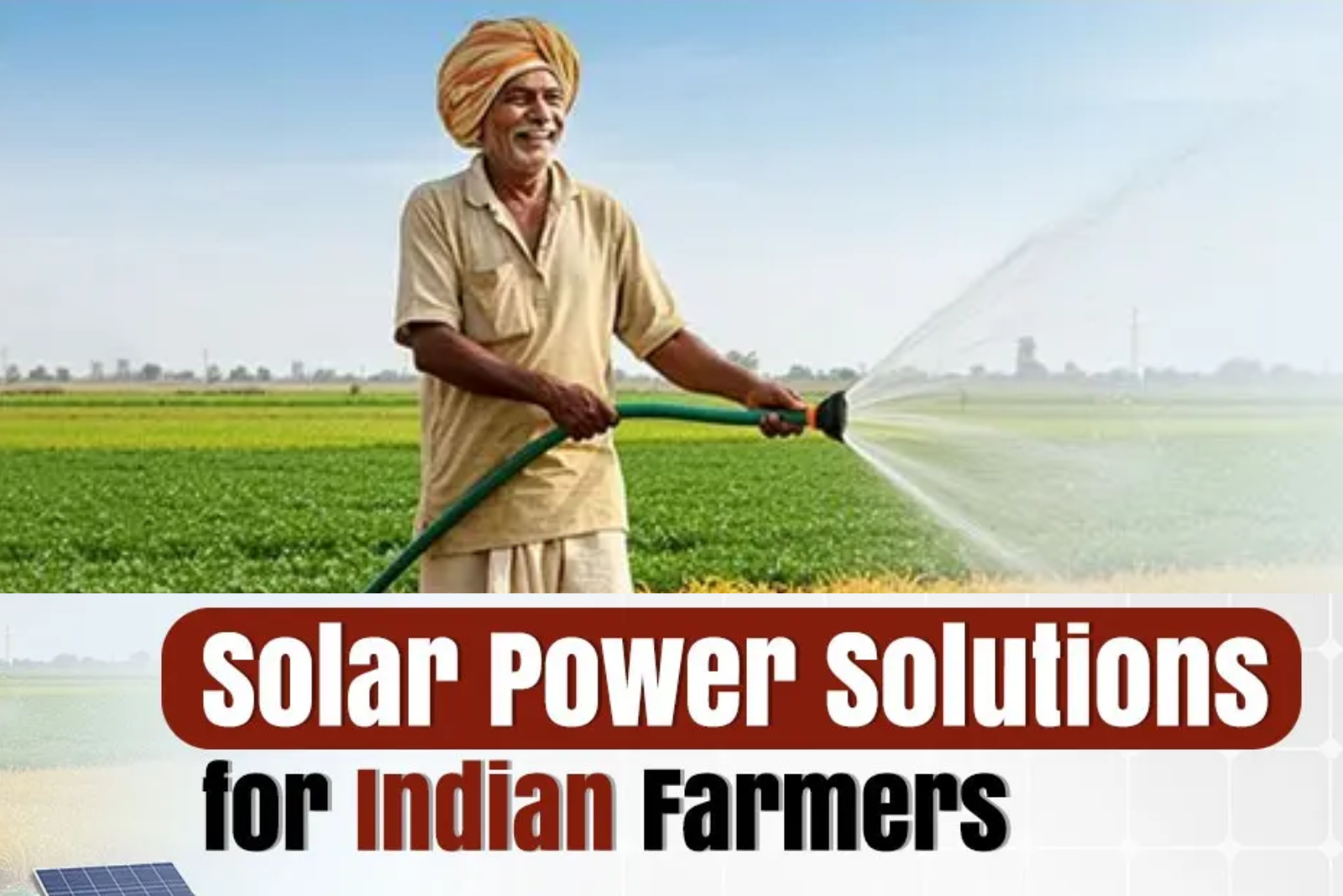Solar Power Solutions for Indian Farmers
- Home
- Blogs

Power cuts in rural areas, rising diesel costs, and unreliable electricity — these are common problems farmers face across India. But there’s a simple, smart, and long-term solution: solar power for agriculture.
Today, more and more farmers are turning to solar energy to run water pumps, lights, cold storages, and even tractors. It saves money, reduces fuel dependency, and works well in areas with little to no power supply.
In this blog, we’ll explain how solar power is changing agriculture in India, its benefits, available systems, and how farmers can adopt it easily.
Also Read: Power Backup Options
Why Solar Power is Perfect for Agriculture
Farmers often need electricity during the day — for pumping water, powering lights, or operating machines. That’s when the sun is at its peak, making solar the most practical energy source.
Here’s why it’s a great fit:
- Abundant sunlight across most Indian villages
- Free power after initial installation
- Low maintenance compared to diesel engines
- Works in remote areas where grid supply is poor
- Government subsidies available to reduce cost
Common Uses of Solar Power in Agriculture
Here are the main ways solar energy helps Indian farmers:
1. Solar Water Pumps
Purpose: To draw water from wells, rivers, or borewells for irrigation
Types: Surface pumps and submersible pumps
Why It’s Useful:
Runs during the day (when needed most)
Replaces expensive diesel pumps
No fuel cost or pollution
Capacity: Available from 1 HP to 10 HP or more
2. Solar Lighting for Farms
Purpose: To light farm areas, cowsheds, and fences at night
Why It’s Useful:
Keeps areas secure from animals or theft
Saves electricity bills
Solar street lights require no wiring
3. Solar-Powered Cold Storage Units
Purpose: To store fruits, vegetables, milk, or flowers at the right temperature
Why It’s Useful:
Reduces spoilage
Helps farmers sell produce later at better prices
Saves on diesel cold storage costs
4. Solar Dryers
Purpose: To dry crops like spices, grains, and herbs using solar heat
Why It’s Useful:
Faster than traditional drying methods
Protects from dust, insects, and rain
Maintains better quality
5. Solar Fencing
Purpose: To protect crops from stray animals
Why It’s Useful:
Lowers loss due to damaged crops
Easy to install and cost-effective in the long term
Benefits of Using Solar Power in Farming
Benefit | Description |
Cost Saving | No recurring fuel cost after setup |
Eco-Friendly | Zero emissions, supports sustainable farming |
Low Maintenance | Once installed, requires minimal servicing |
Long Life | Solar panels last 20–25 years |
Works in Off-Grid Areas | Perfect for villages with poor power supply |
Government Support | 30–90% subsidy under PM-KUSUM and other schemes |
Government Support & Subsidies for Farmers
To promote solar energy, the Indian government offers subsidies under various schemes:
PM-KUSUM Yojana – Helps farmers install solar pumps and systems
Up to 60–90% subsidy depending on state
Covers solar pump installation and grid-connected systems
State-specific programs – Additional support in states like Maharashtra, Rajasthan, Uttar Pradesh, Tamil Nadu, etc.
Farmers can apply through official state nodal agencies or renewable energy departments.
Real Example – Solar Pump Helping a Village in Rajasthan
A farmer in Barmer district, Rajasthan, recently switched from a diesel pump to a 5 HP solar-powered submersible pump. In just one year, he saved over ₹25,000 in fuel costs, reduced downtime, and even helped neighboring farms with shared irrigation.
Many farmers in Punjab, Gujarat, Kashmir, Bihar and Maharashtra are now following the same path — proving that solar is not just a trend, it’s the future of farming.
KLK Ventures – Supporting India’s Solar Agriculture Growth
At KLK Ventures, we help farmers and agribusinesses install high-quality solar systems tailored to their land, water source, and budget.
Our services include:
Solar pump selection and installation
Site inspection and feasibility reports
Solar lighting and fencing solutions
Cold storage solar systems
Help with subsidy applications and approvals
Post-installation support & maintenance
Whether you’re a small farmer or a large farm owner, our team at KLK India is here to help you shift to clean, reliable, and cost-effective solar energy.
FAQs
Q1. Is solar power enough to run farm equipment?
Yes, with the right panel size and inverter, solar can run pumps, lights, and even cold storage units.
Q2. How much subsidy can a farmer get?
Under PM-KUSUM, farmers can get 60–90% subsidy depending on location and setup.
Q3. What is the cost of a solar water pump?
A 3HP solar pump may cost ₹1.5–2.5 lakh before subsidy. Final price depends on brand, type, and site.
Q4. Can solar pumps work in cloudy weather?
They work best in sunlight but still operate (at lower efficiency) during cloudy days.
Q5. How long do solar panels last?
Usually 20–25 years with proper care.
Q6. Are solar systems difficult to maintain?
Not at all. Regular panel cleaning and basic checks are enough.
Q7. Can KLK Ventures install solar systems anywhere in India?
Yes, we provide pan-India solar services with trained engineers and local support.
Q8. Can solar power be used for drip irrigation?
Yes. Solar pumps can easily be connected with drip systems to save both water and energy.
